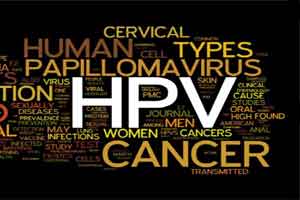- Home
- Editorial
- News
- Practice Guidelines
- Anesthesiology Guidelines
- Cancer Guidelines
- Cardiac Sciences Guidelines
- Critical Care Guidelines
- Dentistry Guidelines
- Dermatology Guidelines
- Diabetes and Endo Guidelines
- Diagnostics Guidelines
- ENT Guidelines
- Featured Practice Guidelines
- Gastroenterology Guidelines
- Geriatrics Guidelines
- Medicine Guidelines
- Nephrology Guidelines
- Neurosciences Guidelines
- Obs and Gynae Guidelines
- Ophthalmology Guidelines
- Orthopaedics Guidelines
- Paediatrics Guidelines
- Psychiatry Guidelines
- Pulmonology Guidelines
- Radiology Guidelines
- Surgery Guidelines
- Urology Guidelines
HPV infection may increase vaginal cancer risk

New York : Persistent infection with the human papillomavirus (HPV) may put women at long-term increased risk of developing anal, vulvar and vaginal cancer.
While the connection between HPV and cervical cancer is well known, the results of this study add anogenital cancers to the list of potential long-range consequences of HPV infection and could add to support for vaccination against the virus, said study author Susanne Kruger Kjaer, Professor at The Danish Cancer Society Research Centre in Copenhagen.
"The HPV vaccine is prophylactic, and if we can prevent HPV infection from occurring in the first place, we can prevent some of these conditions that result from persistent infection," Kjaer noted.
Previous research has shown that certain types of HPV cause cervical intraepithelial neoplasia (CIN), a precancerous condition in which abnormal cells are found on the surface of the cervix.
CIN3 is the highest grade, and the most likely to develop into cervical cancer, Kjaer explained, adding that while infection with HPV is very common, most cases are cleared by the body within a year or two.
Women who develop CIN, particularly a higher grade like CIN2 or CIN3, may be unable to clear the infection, which is one potential explanation for the elevated risk of anogenital cancers.
In order to ascertain whether CIN3 was also associated with anal, vulvar and vaginal cancer, Kjaer and his colleagues studied 2.8 million women who were recorded as living in Denmark between 1978 and 2012, following some women for up to 34 years.
The researchers identified women through Denmark's system of personal identification numbers, which the researchers linked to the Danish Cancer Registry and the Pathology Data Bank to obtain information on verified cases of CIN2 and CIN3, as well as cancer diagnoses.
Of these women, about 104,000 had CIN3 and about 52,000 had CIN2. The rest of them had no history of these conditions.
The study found that when compared with women with no history of the disease, women with CIN3 were 4.2 times more likely to develop anal cancer, four times more likely to develop vulvar cancer and 17 times more likely to develop vaginal cancer.
For women with CIN2, a lower-grade infection that is often less persistent than CIN3, the relative risks were lower, but followed a similar pattern, Kjaer said.
The study was published in Cancer Epidemiology, Biomarkers & Prevention, a journal of the American Association for Cancer Research.

Disclaimer: This site is primarily intended for healthcare professionals. Any content/information on this website does not replace the advice of medical and/or health professionals and should not be construed as medical/diagnostic advice/endorsement or prescription. Use of this site is subject to our terms of use, privacy policy, advertisement policy. © 2020 Minerva Medical Treatment Pvt Ltd